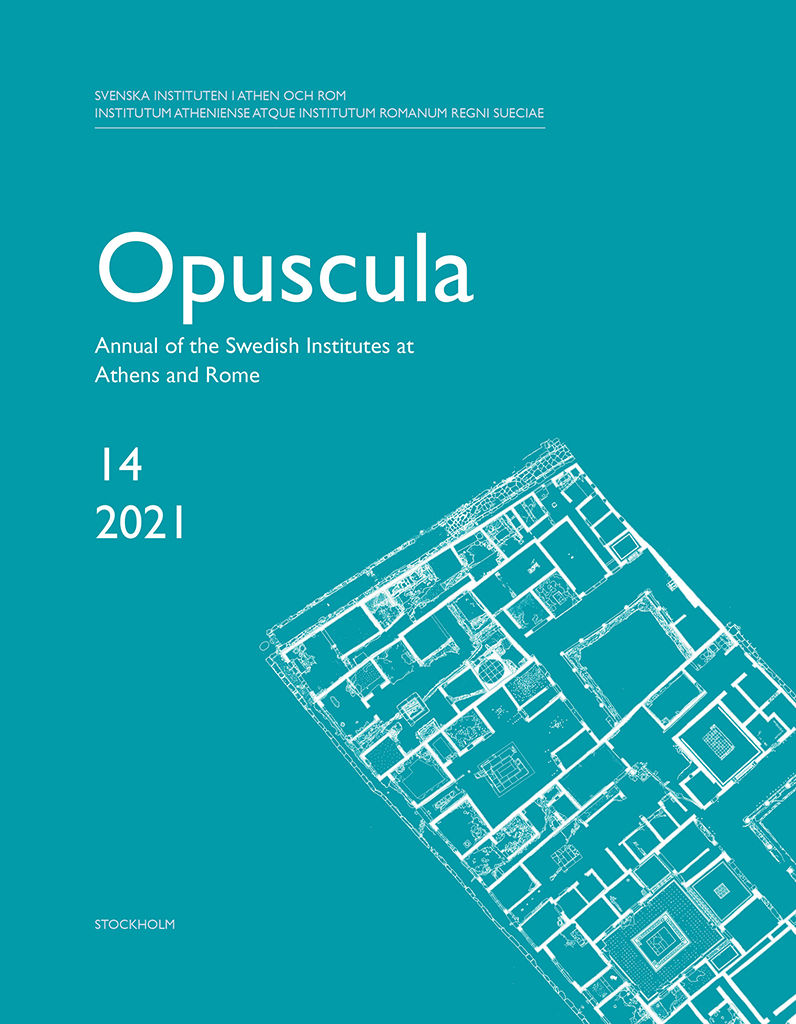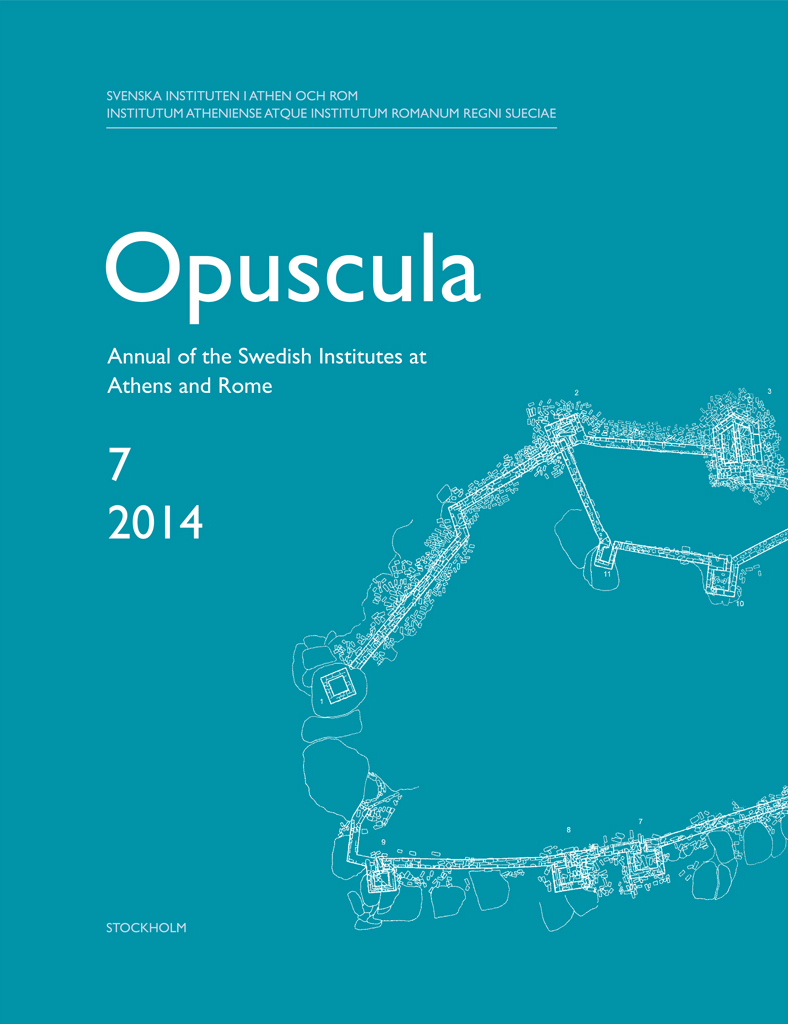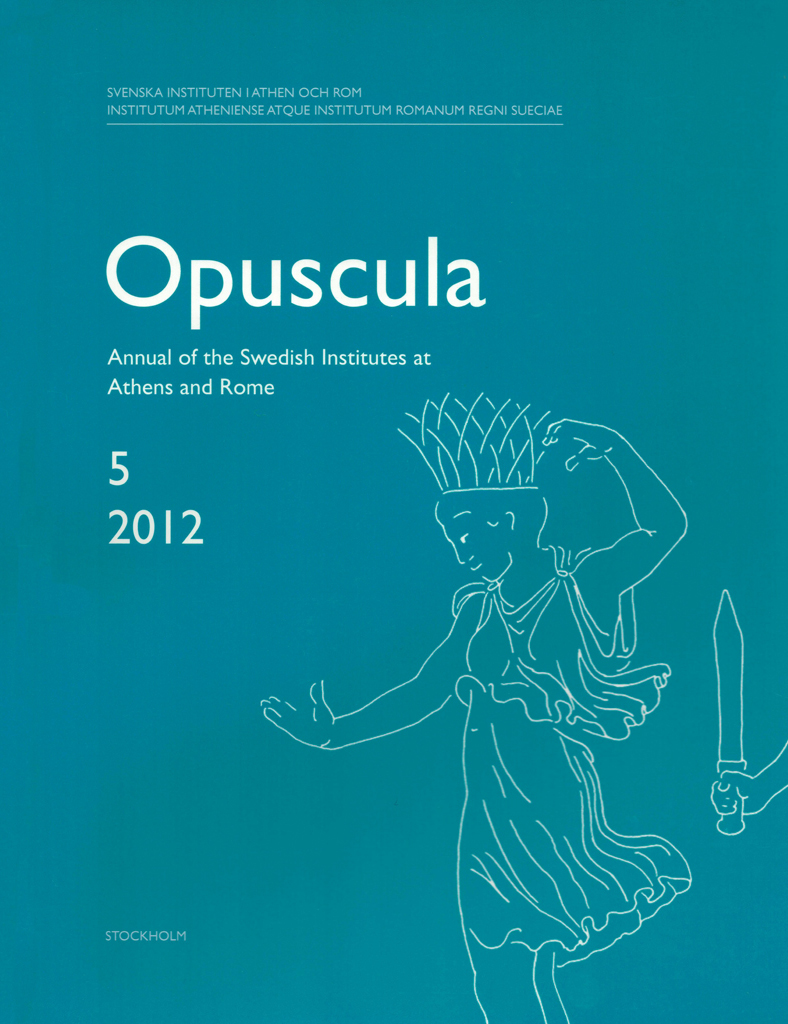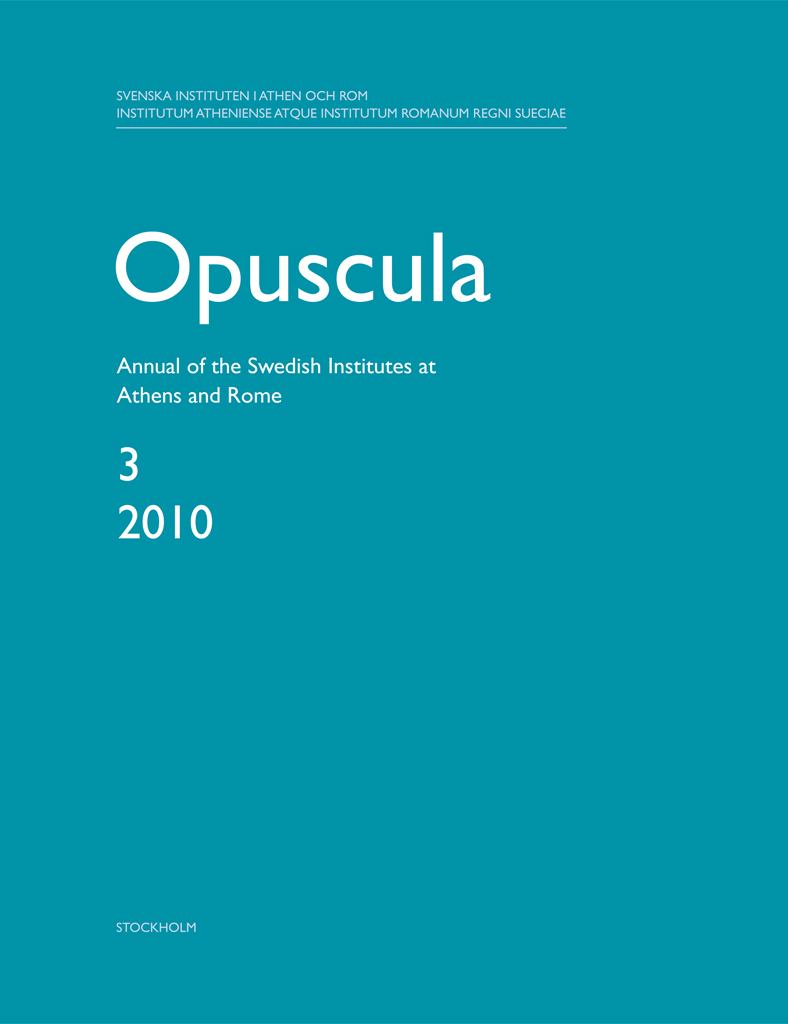Opuscula is published by the Swedish Institutes at Athens and Rome, with the aid of a grant from the Swedish Research Council. Distributed by Eddy.se AB. View journal at ERIH PLUS. All content available with open access. A bronze deposit excavated at Kalaureia in 2016. A statuette of the Herakles Chiaramonti type, a stand and a thymiaterion By Julia Habetzeder (Swedish Institute at Athens & Stockholm University) Abstract This article presents three bronzes found on the island of Poros in 2016, during excavations in Area L, the presumed area of Kalaureia’s ancient settlement, c. 200 m to the south of the Sanctuary of Poseidon. The deposit included: 1. A statuette of the Herakles Chiaramonti type, here suggested to have been produced during the 2nd or 1st century BC; 2. A stand which may have functioned as a thymiaterion (incense burner) or a lamp stand. Judging from close parallels the stand was most likely produced during the 5th or 4th century BC; 3. A high-stemmed dish, which is interpreted as a thymiaterion contemporary with the stand. The items are tentatively suggested to have been used together, perhaps in religious veneration of Herakles. The bronzes are suggested to have been deposited either for what was intended to be temporary…
Opuscula is published by the Swedish Institutes at Athens and Rome, with the aid of a grant from the Swedish Research Council. Distributed by Eddy.se AB. View journal at ERIH PLUS. All content available with open access. The Invitation to the Dance. An intertextual reassessment By Julia Habetzeder (Uppsala University, Sweden) Abstract With its original manifestation generally dated to c. 150 BC, the Invitation to the Dance is a textbook example of Hellenistic sculpture. But despite much scholarly attention there is still no consensus as to what motif the sculpture group depicts. Inspired by intertextual theory, this study catalogues and re-examines 35 sculptures of the female figure and 34 sculptures of the satyr. The article focuses on preserved sculptures, rather than a reconstructed model image. Variations of the repeated forms are highlighted as significant for the interpretation of the types. The reading of the Invitation to the Dance thus put forward suggests that the group composition displays the moment after the satyr has pulled the female’s garment down from her upper body. It is furthermore emphasized that both satyr and female figure were at times—perhaps even predominately—displayed as solitary figures. The satyr’s foot-clapper is suggested to have been included primarily in…
Opuscula is published by the Swedish Institutes at Athens and Rome, with the aid of a grant from the Swedish Research Council. Distributed by Eddy.se AB. View journal at ERIH PLUS. All content available with open access. Book reviews Kristian Göransson | G. Ceserani, Italy’s lost Greece: Magna Graecia and the making of modern archaeology, Oxford: Oxford University Press 2012. 352 pp. ISBN 978-0-19-974427-5 & J. Arthurs, Excavating modernity: The Roman past in Fascist Italy, Ithaca & London: Cornell University Press 2012. 232 pp. ISBN 978-0-8014-4998-7. https://doi.org/10.30549/opathrom-07-14 Örjan Wikander | R. Spain, The power and performance of Roman watermills. Hydro-mechanical analysis of vertical-wheeled watermills (BAR-IS, 1786). Oxford: Archaeopress 2008, xiv + 107 pp. ISBN 978-1-4073-0217-1. https://doi.org/10.30549/opathrom-07-15 Gullög Nordquist | T.F. Tartaron, Maritime networks in the Mycenaean world. Cambridge: Cambridge University Press 2013. ISBN 978-1-107-00298-2. https://doi.org/10.30549/opathrom-07-16 Julia Habetzeder | Kunst von unten? Stil und Gesellschaft in der antiken Welt von der »arte plebea« bis heute (Palilia, 27), eds. F. de Angelis, J.-A. Dickmann, F. Pirson and R. von den Hoff, Deutsches Archäologisches Institut Rom. Wiesbaden 2012. 184 pp. ISBN 978-3-89500-915-0. https://doi.org/10.30549/opathrom-07-17 P.J. Rhodes | C.H. Lyttkens, Economic analysis of institutional change in Ancient Greece: Politics, taxation and rational behaviour (Routledge Explorations…
Opuscula is published by the Swedish Institutes at Athens and Rome, with the aid of a grant from the Swedish Research Council. Distributed by Eddy.se AB. View journal at ERIH PLUS. All content available with open access. The impact of restoration. The example of the dancing satyr in the Uffizi By Julia Habetzeder Abstract The aim of this article is to show that reputed restorations may have an unexpected impact on the study of ancient sculpture. During the 17th–19th centuries, a number of restored antiques were held in exceptionally high regard. One of the consequences of their renown was the production of copies and adaptations in different scales and media. Such reproductions did not distinguish between the ancient and the restored parts of the work. Today these reproductions are centuries old, and in many cases their provenance has long since been forgotten. Therefore, such post-Antique sculptures are easily misinterpreted as ancient. Subsequently, they are at times used as evidence of ancient sculptural production. Needless to say, this may cause flawed notions of Classical sculpture. The complexity of this relationship, between the ancient and the restored, is here exemplified by tracing the impact that a restored motif—“Satyrs with cymbals”—has had on…
Opuscula is published by the Swedish Institutes at Athens and Rome, with the aid of a grant from the Swedish Research Council. Distributed by Eddy.se AB. View journal at ERIH PLUS. All content available with open access. Dancing with decorum. The eclectic usage of kalathiskos dancers and pyrrhic dancers in Roman visual culture By Julia Habetzeder Abstract This article examines two groups of motifs in Roman visual culture: females modelled on kalathiskos dancers, and males modelled on pyrrhic dancers. Eclecticism is emphasized as a strategy which was used to introduce novelties that were appropriate within a Roman cultural context. The figures representing kalathiskos dancers and pyrrhic dancers were both changed in an eclectic manner and this resulted in motifs representing the goddess Victoria, and the curetes respectively. Kalathiskos dancers and eclectic Victoriae occur on many different media at least from the Augustan era and into the 2nd century AD. It is argued here that the establishment of these two motifs in Roman visual culture is closely related to the aesthetics which came to the fore during the reign of Augustus. Thereafter, both kalathiskos dancers and eclectic Victoriae lingered on in the Roman cultural context until many of the material categories…
Opuscula is published by the Swedish Institutes at Athens and Rome, with the aid of a grant from the Swedish Research Council. Distributed by Eddy.se AB. View journal at ERIH PLUS. Content available with open access. Marsyas in the garden? Small-scale sculptures referring to Marsyas in the forum By Julia Habetzeder Abstract While studying a small-scale sculpture in the collections of the Nationalmuseum in Stockholm, I noticed that it belongs to a previously unrecognized sculpture type. The type depicts a paunchy, bearded satyr who stands with one arm raised. To my knowledge, four replicas exist. By means of stylistic comparison, they can be dated to the late second to early third centuries AD. Due to their scale and rendering they are likely to have been freestanding decorative elements in Roman villas or gardens. The iconography of the satyrs of the type discussed is closely related to that of a group of fountain figures. These fountain figures are believed to refer to a motif well known in Roman times: the Marsyas in the forum. In this article I argue that the satyrs of the type discussed refer as well to this once famous depiction of Marsyas. Bibliographical information Julia Habetzeder, ‘Marsyas…





